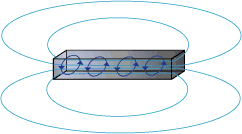Would you like to make this site your homepage? It's fast and easy...
Yes, Please make this my home page!
First lets talk about what makes magnets attract to other materials as well as other magnets.
We know that magnets have flux lines just like the coil of wire, which is a man made magnet and is very predictable. We also know that flux lines will combine with other flux lines as well as repel other flux lines when certain aspects are met. What we don't already know is why these flux lines are able to attract other objects. Magnets are able to attract other objects because flux lines always choose the shortest path to complete a circle and flux lines are able to travel through some objects better then air or space. We also know that flux lines travel outwards which takes work and looping back takes relatively no work. When an iron bar is introduced it also introduces a shortcut because flux lines can travel through iron easier then air. In turn the work it takes to extend these flux lines outwards is converted to force attracting the iron bar towards the magnetic object. This also gives flux lines close to the magnet a shorter path to travel and as an affect makes it harder to separate from one another. It comes apparent that some objects will accept these flux lines and some seem as if they weren't there because the flux lines travel right through the object without disturbing the flux lines.
|
|

|
The bar magnet "man-made" and the natural magnet "loadstone" act identical and to each other as well as coil magnets and is why we are only going to discuss the man made bar magnet in detail.
When you rub "in one direction" an iron rod on a magnet that you are actually creating riptides of electrons within the iron rod. These riptides are a fancy way of saying that you make electrons travel in circles within the magnet. The tides of electrons always occur in multiple instances within the rod while the number tides dictated the strength of the magnet.
Looking at the picture to the left you will notice the blue lines indicating the direction of electron flow within the magnet with respect to the light blue lines indicating the direction of the flux lines.
|
|
|
This is the exact same concept behind the natural magnet and any other forms of magnetism in the electronics field. Many components including the inductor and transformer transmit a fair amount of magnetic interference that can cause some unwanted results with audio sounds and such devices. The trick to overcoming these unwanted outcomes can be as simple as incasing circuits in a tin casing to isolate the flux lines.
|
|
Home |
Contact us |
Our History |
Link to us |
Relations
A Passion Production ©opyright 2000
